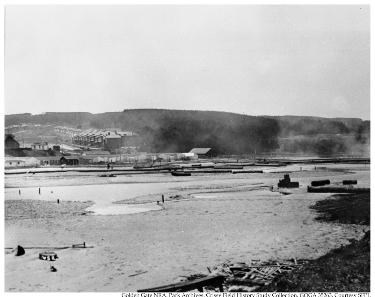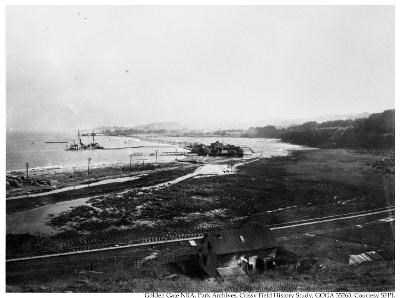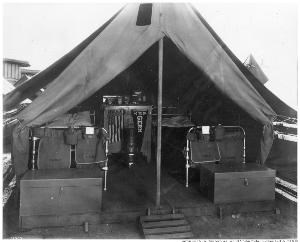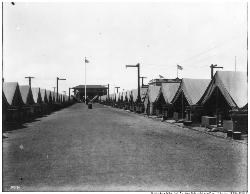|
San Francisco and the military played an early role in the events that would lead to the Exposition. The USS Oregon was built and launched from San Francisco shipyards in 1893. The Oregon was quickly called into service against Spain in the Atlantic. She was forced to make the long journey around South America to Florida. She played a crucial role in drawing attention to the problem of having a navy separated by a large continent. This spurred the decision to construct a waterway which would join the US Navy-the Panama Canal. Later, The Oregon would be present in the bay waters to watch over the exposition. 
The Panama Pacific International Exposition’s main grounds were to be located on the Harbor View mudflats-which is now the Marina. It would be flanked by Fort Mason and the Presidio reservation, both of which were property of the US military. The planners wanted to include these lands in the expo. As part of the plans, an exposition building would be built on Fort Mason to be used later as a main post and any improvements to the Presidio would be left for the benefit of the military. Secretary of War General Dickinson found the proposal unfavorable and refused the request. However, he soon resigned his position. The incoming secretary and the Committee of Military Affairs granted the use. 
Once the location was mapped exhaustively, work could begin. The mudflats were filled by dredging the bay. It took one hundred and forty seven days to complete. Over one million cubic yards of the bay was pumped in to the flats to create the ground that the exposition would sit on. Once construction was complete, the Exposition occupied six hundred and thirty five acres. The military’s presence at the exposition was ubiquitous. If there was a ceremony, a building to be dedicated or an event being held, you can be sure it was preceded with a military parade. The infantry, cavalry and military bands all participated. The military took the opportunity the fair presented to display some of their might to the fair goers. They would demonstrate the coastal defenses by exploding submarine mines and firing off the coast artillery for spectators. These displays were made the more impressive and important given the escalation of war in Europe hanging on the minds of the world. The war prevented the exposition’s plans for a grand International Military Tournament, which would have been a considerable display. An Enlisted Men’s Club House was constructed on the Avenue of Nations to accommodate the thousands of enlisted working, living and visiting the Expo. It included a lunge, reading room, restaurant, billiards, movie theatre and mailroom. All enlisted were admitted free of charge. After the Exposition, the facility was donated to the military and moved onto the Presidio ground to serve as the Army and Navy Y.M.C.A. A warehouse at the end of The Zone on Van Ness Street was fitted up as a barracks, which could house over 1,000 troops at a time to accommodate the vast numbers visiting the fair. 
The Marines assembled a model camp just west of the state buildings which served to educate the public and included: tents, a mess hall, a barber shop, bath houses, a mess hall, kitchen and military hospital. The marines participated in running the expo. They were selected to run the Scintillator, which was a series of searchlights of various color, used to illuminate the fair, the Tower of Jewels and the night sky. 
As the fair drew to a close the Marines and all military numbers began to dwindle with their departures. A crew from the Yerba Buena Island Naval Training Station took up residence and served to fill the roles vacated by the departed. They even saw a bit of action on closing day. With crowds clambering to get into the final day of action they eventually became too much for the gates to handle. Some merriment seekers began to push against the vehicle entrance gate. For fear that it may collapse and allow the throngs to enter uncounted and fees uncollected (ruining the fair’s impeccable record), they sent for the trainees. They set up a line just in time. The gate fell and the mass moved in to find them standing rifles in hand. This was all it took. The visitors backed up and the trainees advanced until the gate was cleared and restored. A single person could have spent 24 hours a
day at the expo - every day the expo was open - and still not have seen it
all... Visit the Exposition Palaces where the
world showcased their very best Head west of the main exposition grounds to
visit the State Buildings Take a tour of the world as you walk along
the Avenue of Nations and view the Foreign Pavilions The Presidio has a long military history. See
how the Military's Role shaped the
expo. Visit the most sensational sixty five acres at the exposition along The "Joy" Zone Aviators, athletes and drivers competed
during the year of the exposition in many types of Sports and Athletics For More Information: To see more photos and maps, please visit the Panama-Pacific International Exhibition home page. To learn more about the events leading up to the fair, visit Prologue to the Panama-Pacific International Exhibition. To learn about the legacy of the Panama-Pacific International Exhibition and its impact on San Francisco, please visit The Legacy of the Panama-Pacific International Exhibition. |
Last updated: February 28, 2015
